| Article ID | Journal | Published Year | Pages | File Type |
|---|---|---|---|---|
| 225030 | Journal of Food Engineering | 2006 | 16 Pages |
The dynamic rheological properties of chitosan solutions have been investigated in terms of ionic strength and chitosan concentration for entangled systems. The overlap concentration C* and the entanglement concentration Ce have first been determined to identify the dilute, semi-dilute and concentrated entangled regimes. In dilute solutions, the effect of ionic strength (I) on the intrinsic viscosity ([η]) has been interpreted in terms of the Debye electrostatic screening length. The intrinsic viscosity, the radius of gyration and the persistence length decreased with increasing ionic strength, due to the screening of the electrostatic charges on the chitosan chains by the salt resulting in increased chain flexibility. For concentrated solutions, dynamic measurements were performed and the relaxation spectra were calculated from the storage (G′) and loss (G″) moduli characterized in the linear viscoelastic region. For all chitosan concentrations and ionic strengths, the time-weighted stress relaxation spectra showed only one peak. However, the width of the spectra increased with increasing polymer concentration, indicating a larger distribution of relaxation modes due to more entanglements and interchain interactions. The mean relaxation time (τH), related to reptation, and the zero-shear viscosity (η0) were found to follow power-law expressions of the chitosan concentration, with τH ∼ C3.1 and η0 ∼ C4.1, respectively, with the high exponents indicating the associating character of the polymer. The non-Newtonian nature (elastic properties and shear-thinning behavior) of the chitosan solutions increased with increasing chitosan concentration and decreasing ionic strength.
